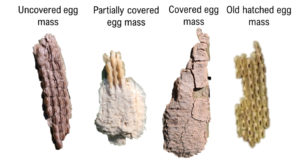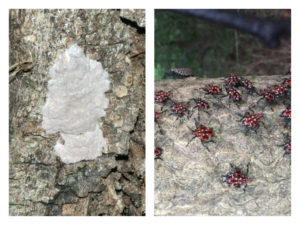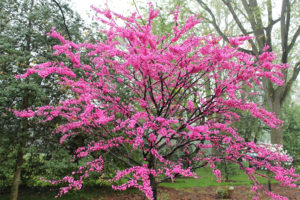Scrape Those Lanternflies Away
March 23rd, 2021
Many of you no doubt noticed that new bug in town late last winter – the spotted lanternfly.

These are various stages of spotted lanternfly egg masses.
(Credit: Heather Leach/Penn State University)
This rather large (pinky-sized) flying insect with the spotted grayish-tan wings (red underneath) has now made its way from its initial 2014 invading point of Berks County to throughout the Harrisburg area.
Lanternfly adults have a 70-plant appetite (especially grapes and maple, walnut, birch, beech, cherry, and willow trees), making it a threat to a lot of our landscape plants if/when their numbers balloon.
Although lanternflies are currently in their egg stage, this is actually the best time of year to deal with this latest imported pest.
Lanternfly egg masses look like a gray smear of mud with a waxy covering. They’re typically seen clinging on tree trunks, firewood, stones, outdoor furniture, or for that matter, any solid, flat, outdoor surface.

A lanternfly egg mass on a tree trunk, left, and what newly hatched lanternfly nymphs look like.
(Credit: Penn State Extension)
By smashing or otherwise getting rid of the masses, you can eliminate anywhere from 30 to 50 new lanternflies per mass.
Penn State Extension recommends scraping the egg masses into jars or plastic bags with a small amount of alcohol or hand sanitizer in order to kill the eggs. Just scraping them off and letting the masses drop to the ground won’t do the trick.
See a Penn State Extension video on how to scrape spotted lanternfly egg masses
Pay special attention if you saw spotted lanternfly adults in or near your yard late last summer and early fall.












